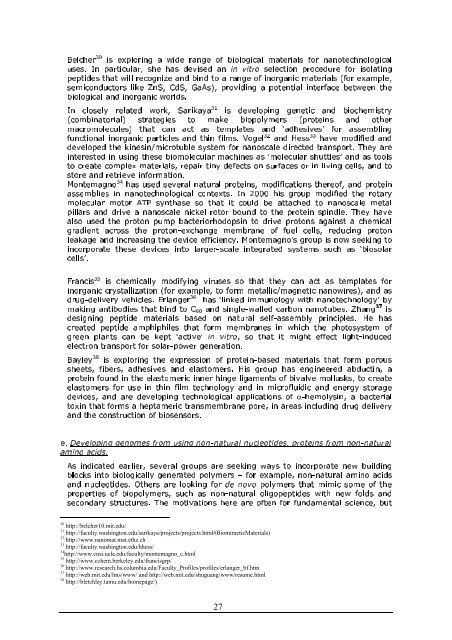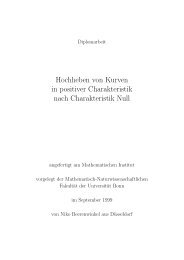Synthetic Biology Applying Engineering to Biology - Europa
Synthetic Biology Applying Engineering to Biology - Europa
Synthetic Biology Applying Engineering to Biology - Europa
You also want an ePaper? Increase the reach of your titles
YUMPU automatically turns print PDFs into web optimized ePapers that Google loves.
Belcher 30<br />
In particular, she has devised an in vitro selection procedure for isolating<br />
uses.<br />
that will recognize and bind <strong>to</strong> a range of inorganic materials (for example,<br />
peptides<br />
like ZnS, CdS, GaAs), providing a potential interface between the<br />
semiconduc<strong>to</strong>rs<br />
and inorganic worlds.<br />
biological<br />
In closely related work, Sarikaya 31<br />
strategies <strong>to</strong> make biopolymers (proteins and other<br />
(combina<strong>to</strong>rial)<br />
that can act as templates and ‘adhesives’ for assembling<br />
macromolecules)<br />
32 33 and thin films. Vogel and Hess have modified and<br />
functional inorganic particles<br />
system for nanoscale directed transport. They are<br />
kinesin/microtuble the developed<br />
in using these biomolecular machines as ‘molecular shuttles’ and as <strong>to</strong>ols<br />
interested<br />
create complex materials, repair tiny defects on surfaces or in living cells, and <strong>to</strong><br />
<strong>to</strong><br />
and retrieve information.<br />
s<strong>to</strong>re 34<br />
has used several natural proteins, modifications thereof, and protein<br />
Montemagno<br />
in nanotechnological contexts. In 2000 his group modified the rotary<br />
assemblies<br />
mo<strong>to</strong>r ATP synthase so that it could be attached <strong>to</strong> nanoscale metal<br />
molecular<br />
and drive a nanoscale nickel ro<strong>to</strong>r bound <strong>to</strong> the protein spindle. They have<br />
pillars<br />
used the pro<strong>to</strong>n pump bacteriorhodopsin <strong>to</strong> drive pro<strong>to</strong>ns against a chemical<br />
also<br />
across the pro<strong>to</strong>n-exchange membrane of fuel cells, reducing pro<strong>to</strong>n<br />
gradient<br />
and increasing the device efficiency. Montemagno’s group is now seeking <strong>to</strong><br />
leakage<br />
these devices in<strong>to</strong> larger-scale integrated systems such as ‘biosolar<br />
incorporate<br />
cells’.<br />
Francis 35<br />
crystallization example, <strong>to</strong> form metallic/magnetic nanowires), and as<br />
inorganic 36<br />
(for<br />
Erlanger has ‘linked immunology with nanotechnology’ by<br />
vehicles. drug-delivery<br />
antibodies that bind <strong>to</strong> C 60 and single-walled carbon nanotubes. Zhang 37 is<br />
making<br />
peptide materials based on natural self-assembly principles. He has<br />
designing<br />
peptide amphiphiles that form membranes in which the pho<strong>to</strong>system of<br />
created<br />
plants can be kept ‘active’ in vitro, so that it might effect light-induced<br />
green<br />
Bayley 38<br />
fibers, adhesives and elas<strong>to</strong>mers. His group has engineered abductin, a<br />
sheets,<br />
found in the elas<strong>to</strong>meric inner hinge ligaments of bivalve mollusks, <strong>to</strong> create<br />
protein<br />
for use in thin film technology and in microfluidic and energy s<strong>to</strong>rage<br />
elas<strong>to</strong>mers<br />
and are developing technological applications of α-hemolysin, a bacterial<br />
devices,<br />
that forms a heptameric transmembrane pore, in areas including drug delivery<br />
<strong>to</strong>xin<br />
the construction of biosensors.<br />
and<br />
Developing genomes from using non-natural nucleotides, proteins from non-natural<br />
e.<br />
acids.<br />
amino<br />
indicated earlier, several groups are seeking ways <strong>to</strong> incorporate new building<br />
As<br />
in<strong>to</strong> biologically generated polymers – for example, non-natural amino acids<br />
blocks<br />
nucleotides. Others are looking for de novo polymers that mimic some of the<br />
and<br />
of biopolymers, such as non-natural oligopeptides with new folds and<br />
properties<br />
is exploring a wide range of biological materials for nanotechnological<br />
is developing genetic and biochemistry<br />
is chemically modifying viruses so that they can act as templates for<br />
electron transport for solar-power generation.<br />
is exploring the expression of protein-based materials that form porous<br />
secondary structures. The motivations here are often for fundamental science, but<br />
30 http://belcher10.mit.edu/<br />
31 http://faculty.washing<strong>to</strong>n.edu/sarikaya/projects/projects.html#BiomimeticMaterials)<br />
32 http://www.nanomat.mat.ethz.ch<br />
33 http://faculty.washing<strong>to</strong>n.edu/hhess/<br />
34 http://www.cnsi.ucla.edu/faculty/montemagno_c.html<br />
35 http://www.cchem.berkeley.edu/francisgrp/<br />
36 http://www.research.hs.columbia.edu/Faculty_Profiles/profiles/erlanger_bf.htm<br />
37 http://web.mit.edu/lms/www/ and http://web.mit.edu/shuguang/www/resume.html<br />
38 http://bletchley.tamu.edu/homepage/)<br />
27




